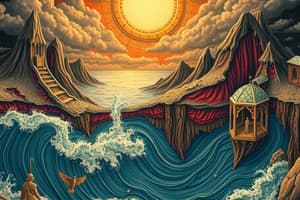Podcast
Questions and Answers
Where does the lava come from for volcanic island arcs and continental volcanic arcs?
Where does the lava come from for volcanic island arcs and continental volcanic arcs?
Volcanic island arcs are constructed on oceanic lithosphere, while continental volcanic arcs see rising mantle-derived magma assimilate continental material.
How is magma like a bottle of soda, and what happens to both substances when the pressure changes?
How is magma like a bottle of soda, and what happens to both substances when the pressure changes?
Both magma and soda contain dissolved gases that are kept in solution under high pressure. When pressure changes, gas bubbles can form.
What is the importance of monitoring volcanic activity?
What is the importance of monitoring volcanic activity?
To prevent potential disruptions to business and travel and to protect populations from eruptions.
How can climate affect the weather?
How can climate affect the weather?
Provide an example of a positive aspect of weathering.
Provide an example of a positive aspect of weathering.
How can sulfur dioxide gas erupted from a volcano affect global climate?
How can sulfur dioxide gas erupted from a volcano affect global climate?
What is the temperature at a depth of 2 miles, assuming a surface temperature of 20 degrees Celsius?
What is the temperature at a depth of 2 miles, assuming a surface temperature of 20 degrees Celsius?
How would the geothermal gradient change if a borehole were drilled near Yellowstone National Park?
How would the geothermal gradient change if a borehole were drilled near Yellowstone National Park?
How do scientists use earthquakes to predict potential volcanic eruptions?
How do scientists use earthquakes to predict potential volcanic eruptions?
Why isn't quartz considered a ferromagnesian mineral despite the original melt containing iron?
Why isn't quartz considered a ferromagnesian mineral despite the original melt containing iron?
Which type of volcano is considered the most dangerous to live near, and why?
Which type of volcano is considered the most dangerous to live near, and why?
Flashcards
Volcanic Island Arcs
Volcanic Island Arcs
Form on oceanic lithosphere and produce basaltic lava.
Continental Volcanic Arcs
Continental Volcanic Arcs
Form on continental lithosphere, producing andesitic or rhyolitic magmas.
Magma & Soda Analogy
Magma & Soda Analogy
Magma and soda both contain dissolved gases that can bubble out when pressure decreases.
Mechanical Weathering
Mechanical Weathering
Signup and view all the flashcards
Chemical Weathering
Chemical Weathering
Signup and view all the flashcards
Positive Aspects of Weathering
Positive Aspects of Weathering
Signup and view all the flashcards
Sulfur Dioxide (SO2)
Sulfur Dioxide (SO2)
Signup and view all the flashcards
Geothermal Gradient
Geothermal Gradient
Signup and view all the flashcards
Shallow Earthquakes
Shallow Earthquakes
Signup and view all the flashcards
Ferromagnesian Minerals
Ferromagnesian Minerals
Signup and view all the flashcards
Composite Cone Volcano Dangers
Composite Cone Volcano Dangers
Signup and view all the flashcards
Study Notes
Volcanic Island Arcs vs. Continental Volcanic Arcs
- Volcanic island arcs form on oceanic lithosphere and primarily produce basaltic lava due to flux melting and interaction with oceanic lithosphere.
- Continental volcanic arcs derive from rising mantle-derived magma that assimilates silica-rich continental material, leading to the production of andesitic or rhyolitic magmas.
Magma and Soda Analogy
- Both magma and soda contain dissolved gases, which remain in fluid form under high pressure.
- When pressure decreases, gas bubbles can form, leading to eruptive activity in magmas, similar to carbonation loss in opened soda bottles.
Importance of Monitoring Volcanic Activity
- Volcanoes near population centers can significantly disrupt business, travel, and pose risks to human life during eruptions.
Climate's Effect on Weathering
- Cold and dry climates promote mechanical weathering processes.
- Warm and wet climates favor chemical weathering, altering geological materials.
Positive Aspects of Weathering
- Weathering is essential for soil production, necessary for agriculture.
- It provides materials for artistic endeavors and exposes economically valuable deposits through erosion.
Sulfur Dioxide and Global Climate
- Sulfur dioxide gas can bond with atmospheric water, forming reflective aerosols that cool the Earth's surface by reflecting solar radiation.
Calculating Temperature at Depth
- At a depth of 2 miles (3.2 km) below the surface, the temperature is calculated to be approximately 64 degrees Celsius, based on a gradient of 20 degrees C/km.
Geothermal Gradient near Yellowstone
- The geothermal gradient in areas like Yellowstone is higher due to geologically recent volcanic activity and proximity of magma to the surface.
Earthquakes and Volcanic Eruption Prediction
- Shallow earthquakes beneath a volcano signal magma movement toward the surface, with increasing seismic unrest often preceding violent eruptions.
Ferromagnesian Minerals and Cooling Magma
- Early crystallizing minerals, such as olivine, sequester iron in solid form, preventing quartz and later minerals from incorporating iron into their structures.
Dangers of Composite Cone Volcanoes
- Composite cone volcanoes are highly dangerous due to violent eruptions that generate pyroclastic flows, ash falls, and lahars. These hazards can lead to substantial damage and casualties, affecting areas far from the volcano itself.
Studying That Suits You
Use AI to generate personalized quizzes and flashcards to suit your learning preferences.




